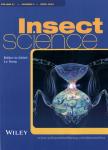Bacterial microbiome of Coptotermes curvignathus (Isoptera: Rhinotermitidae) reflects the coevolution of species and dietary pattern
Bacterial microbiome of Coptotermes curvignathus (Isoptera: Rhinotermitidae) reflects the coevolution of species and dietary pattern作者机构:Faculty of Agriculture and Food Sciences Universiti Putra Malaysia Bintulu Sarawak Campus Sarawak Malaysia Genome InstituteJalan Bangi Lama 43000 Kajang Faculty of Science and Technology UniversiU Kebangsaan Malaysia 43600 UKM BangiSelangor Malaysia
出 版 物:《Insect Science》 (昆虫科学(英文版))
年 卷 期:2014年第21卷第5期
页 面:584-596页
核心收录:
学科分类:0710[理学-生物学] 083002[工学-环境工程] 0830[工学-环境科学与工程(可授工学、理学、农学学位)] 07[理学] 08[工学] 09[农学] 0904[农学-植物保护] 0901[农学-作物学] 0713[理学-生态学]
基 金:supported by grants from the Ministry of Science, Technology and Innovation Malaysia under Genomics and Molecular Biology R&D Initiatives Universiti Putra Malaysia under Research University Grant Scheme
主 题:Coptotermes curvignathus diet preference gut microbiome selection
摘 要:Coptotermes curvignathus Holmgren is capable of feeding on living trees. This ability is attributed to their effective digestive system that is furnished by the termite's own cellulolytic enzymes and cooperative enzymes produced by their gut microbes. In this study, the identity of an array of diverse microbes residing in the gut of C. curvignathus was revealed by sequencing the near-full-length 16S rRNA genes. A total of 154 bacterial phylotypes were found. The Bacteroidetes was the most abundant phylum and accounted for about 65% of the gut microbial profile. This is followed by Firmicutes, Actinobacteria, Spirochetes, Proteobacteria, TM7, Deferribacteres, Planctomycetes, Ferrucomicrobia, and Termite Group 1. Based on the phylogenetic study, this symbiosis can be a result of long coevolution of gut enterotypes with the phylogenic distribution, strong selection pressure in the gut, and other speculative pressures that determine bacterial biome to follow. The phylogenetic distribution of cloned rRNA genes in the bacterial domain that was considerably different from other termite reflects the strong selection pressures in the gut where a proportional composition of gut microbiome of C. curvignathus has established. The selection pressures could be linked to the unique diet preference of C. curvignathus that profoundly feeds on living trees. The delicate gut microbiome composition may provide available nutrients to the host as well as potential protection against opportunistic pathogen.



